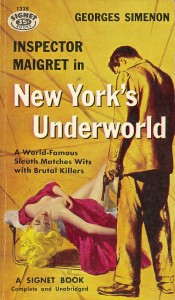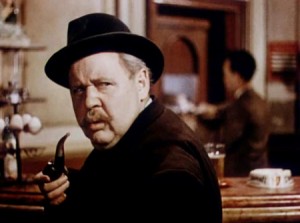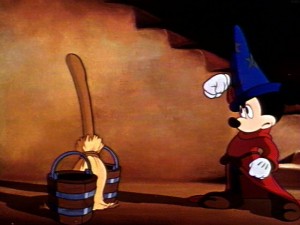 “The test of a vocation is the love of the drudgery it involves.”
“The test of a vocation is the love of the drudgery it involves.”
Logan Pearsall Smith, Afterthoughts
Terry Teachout on the arts in New York City
 I’m not particularly obsessive by nature, but I do have a very orderly mind, a trait that Mrs. T alternately regards as endearing and exasperating. Hence I was delighted to learn that Penguin has embarked on a uniform paperback edition of Georges Simenon’s seventy-five Maigret novels, all of which will be freshly translated and published in chronological order.
I’m not particularly obsessive by nature, but I do have a very orderly mind, a trait that Mrs. T alternately regards as endearing and exasperating. Hence I was delighted to learn that Penguin has embarked on a uniform paperback edition of Georges Simenon’s seventy-five Maigret novels, all of which will be freshly translated and published in chronological order.
I’ve dipped a toe into the Maigret novels on more than one occasion, and I’ve also read and liked (if that’s the word) a few of Simenon’s shockingly black romans durs, of which New York Review Books has lately reprinted a selection. In addition, I’ve read Patrick Marnham’s The Man Who Wasn’t Maigret: A Portrait of Georges Simenon, a highly readable biography of a vain, opportunistic man who by all accounts appears to have been a singularly unattractive character.
I know enough of Simenon’s work, in short, to be impressed by it, and in particular to understand the enduring appeal of the Maigret novels and their principal character, which Julian Symons aptly summarized in Bloody Murder: From the Detective Story to the Crime Novel, his justly admired 1972 study of the mystery story and its close relations:
The Maigret stories stand quite on their own in crime fiction, bearing little relation to most of the other work done in the field. (Simenon is not much interested in crime stories, and has read few of them.) The bases of the stories are often slight, almost anecdotal. There are no great feats of ratiocination in them, and the problems they present are human as much as they are criminal. The ambience of the stories is wonderfully real, the characters are true and often memorable, yet we are not often emotionally moved by them. Maigret’s detached sympathy becomes our own, and like him we do not care to dig too deeply into the roots of crime, we are ready to move on to another case. Simenon is an undoubted master of the crime story, but his mastery rests primarily in the creation of Jules Maigret….He is one of the most completely realized characters in all modern fiction.
Why, then, haven’t I read more Maigret novels? In part because there are so many of them, making it hard to know where to dive in—but also because they’ve been reprinted virtually at random over the years. Because I have an orderly mind, I’m reflexively disinclined to fish at random in so monstrously large an oeuvre. I like to know where to start, and I like, when possible, to begin at the beginning and proceed from there.
 Heretofore I couldn’t do that without going to a great deal of trouble, but Penguin has now simplified the task, and I plan to get started during our visit to Stonington by reading the first Maigret novel, Pietr-le-Letton, originally published in 1931, which is variously known in English as The Strange Case of Peter the Lett and Maigret and the Enigmatic Lett but which David Bellos has now correctly translated as Pietr the Latvian.
Heretofore I couldn’t do that without going to a great deal of trouble, but Penguin has now simplified the task, and I plan to get started during our visit to Stonington by reading the first Maigret novel, Pietr-le-Letton, originally published in 1931, which is variously known in English as The Strange Case of Peter the Lett and Maigret and the Enigmatic Lett but which David Bellos has now correctly translated as Pietr the Latvian.
And what will I gain by beginning at the beginning? I can’t say yet. Very possibly nothing. But that’s my usual way of doing things, and since you can’t consume all of the art in the world simultaneously, I find it as good a way as any to go about accumulating aesthetic experience without falling victim to the meaningless randomness that is the curse of autodidacticism. You can chew through whole shelves of books without becoming educated in the process. On the other hand, the prig with a too-orderly mind needlessly deprives himself of valuable experience, and while I try to strike a happy medium between these two extremes, I have no doubt that I tend to err on the former side.
Perhaps it would have been better for me, spiritually speaking, to pick five Maigret novels out of a hat and read them at a single go. But I didn’t, and now, at the age of fifty-eight, I’m about to find out what I’ve been missing all these years. I’ll keep you posted.
* * *
The Man on the Eiffel Tower, a 1949 film starring and directed by Burgess Meredith in which Charles Laughton plays Inspector Maigret. The film was shot on location in Paris:
One thing that most teenagers neither know nor expect to see in movies is death, the ultimate reality of life. I’m not talking about the ersatz mass murders that are the subject matter of your average Hollywood shoot-’em-up, but the real wrong thing itself, the knowledge of which is not normally accessible to young people, least of all by going to the local multiplex. Truth sometimes finds its way into the movies–accidents happen–but when it comes to death, Hollywood is incapable of honesty, and the bigger the budget, the balder the lies. Movie stars live forever or die nobly, uttering memorable last words and expiring with a smile; you never see the catheter, or smell the pus. Even the appalling simplicity of violent death is beyond the imaginative grasp of most directors. It always seemed to me perfectly appropriate that when Janet Leigh took her last shower in Psycho, the blood running down the drain was really chocolate syrup. …
Read the whole thing here.
 Longtime readers of this blog won’t need to be told that I have what could be politely called a vacation problem. It stands to reason, since I work at home, love what I do, and travel regularly to places I like as part of my job. Worse yet, I’m a professional writer, which means that even though I know better, a part of me can’t help but feel that no experience is complete until it’s been described in words. Add to all this the seductive ubiquity of the Web and you’ve got a recipe for…well, probably not outright workaholism, but certainly a state of being that will be all too familiar to anyone whose life and work, like mine, are very closely integrated. Am I “working” when I spend an evening at the Westside Theatre watching a performance of Satchmo at the Waldorf with a friend from out of town? Am I working now?
Longtime readers of this blog won’t need to be told that I have what could be politely called a vacation problem. It stands to reason, since I work at home, love what I do, and travel regularly to places I like as part of my job. Worse yet, I’m a professional writer, which means that even though I know better, a part of me can’t help but feel that no experience is complete until it’s been described in words. Add to all this the seductive ubiquity of the Web and you’ve got a recipe for…well, probably not outright workaholism, but certainly a state of being that will be all too familiar to anyone whose life and work, like mine, are very closely integrated. Am I “working” when I spend an evening at the Westside Theatre watching a performance of Satchmo at the Waldorf with a friend from out of town? Am I working now?
Whatever the answers to these questions, the fact remains that I rarely take full-fledged vacations. When Mrs. T and go out of town, it’s generally to see a show or visit a theater festival, and when we spend a longer stretch of time on our beloved Sanibel Island, I’ve usually got to work on a book, play, or libretto while we’re there, or at least knock out a couple of Wall Street Journal columns. The longest period of time that I’ve been away from home in decades was the five-week stint that I spent working on Satchmo and Duke: A Life of Duke Ellington at the MacDowell Colony in 2012, and while it was near-pure bliss, it definitely wasn’t a vacation.
 So yes, I have something of a problem. It’s a nice one to have, but that doesn’t make it any less of a problem. Hence our plans for the week ahead: today Mrs. T and I are spending the evening at a family barbecue in rural Connecticut, and since we do love to be beside the sea, we’ll drive down on Tuesday to Stonington, the quaint little coastal town where we retreated for three happy days in between my visit to MacDowell and the start of rehearsals for Satchmo at the Waldorf. We’re staying there through Saturday, and I’ve already filed this Friday’s drama column and my monthly Commentary essay and pre-posted my blog entries for the week, meaning that I don’t have to do any writing during our holiday.
So yes, I have something of a problem. It’s a nice one to have, but that doesn’t make it any less of a problem. Hence our plans for the week ahead: today Mrs. T and I are spending the evening at a family barbecue in rural Connecticut, and since we do love to be beside the sea, we’ll drive down on Tuesday to Stonington, the quaint little coastal town where we retreated for three happy days in between my visit to MacDowell and the start of rehearsals for Satchmo at the Waldorf. We’re staying there through Saturday, and I’ve already filed this Friday’s drama column and my monthly Commentary essay and pre-posted my blog entries for the week, meaning that I don’t have to do any writing during our holiday.
Will I break my professional fast? That remains to be seen. But I’ve packed a bagful of inviting-looking books and begged Mrs. T to do her damnedest to keep me from writing anything between now and Saturday night. (It’ll be a bad sign if you catch me tweeting.)
Cross your fingers, please.
 Assuming that all goes well, the blog that has occupied this space largely unaltered since 2003 will have undergone a radical change in appearance soon after or by the time you get around to reading these words. Doug McLennan of ArtsJournal, which hosts “About Last Night,” has moved the main site and all of its affiliated blogs to a new platform and in the process has optimized them for viewing on handheld computing devices. This necessitated a dramatic redesign, and when Doug pulls the switch at some point today, you’ll see what he’s wrought.
Assuming that all goes well, the blog that has occupied this space largely unaltered since 2003 will have undergone a radical change in appearance soon after or by the time you get around to reading these words. Doug McLennan of ArtsJournal, which hosts “About Last Night,” has moved the main site and all of its affiliated blogs to a new platform and in the process has optimized them for viewing on handheld computing devices. This necessitated a dramatic redesign, and when Doug pulls the switch at some point today, you’ll see what he’s wrought.
Even as I was ArtsJournal’s very first blogger, so am I the very last one to move to the new platform. I put it off for as long as I could, not wanting to have to stand on my head, technically speaking, while simultaneously finishing Duke: A Life of Duke Ellington and moving my first play to an off-Broadway theater. But the time has come, so here goes nothing.
I’ve taken this opportunity to scrap most of the various modules in the right-hand column, which I no longer update with any consistency and so decided had become superfluous. But all the other features of “About Last Night” remain intact. I hope you like what you see, and I hope you’ll continue to visit me regularly.
Needless to say, various things will undoubtedly go wrong along the way. Bear with me as I grope my way into a brave new world—and do not adjust your set.
An ArtsJournal Blog